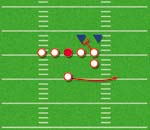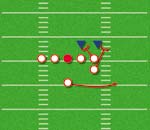AMERICAN FOOTBALL MONTHLY THE #1 RESOURCE FOR FOOTBALL COACHES
|
|
Article Categories
|
Dashing the Defenseby: Dan DoddOffensive coordinator, University of New Mexico© More from this issueAS DEFENSES HAVE CONTINUED to downsize in an effort to get more speed on the field, the offense has had to find creative ways to change the quarterback's launch position in the passing game. And although the drop-back passing game is still a staple, we utilize our Dash series to move the QB in the shotgun. PROTECTION The field offensive tackle's rule is to block the B Gap defender. The OT's technique is the same as a down block. He will "seal" a 3 technique defensive tackle (Diagram 1)

Diagram 1

Diagram 2


|
|
|
NOT A SUBSCRIBER?
Subscribe
now to start receiving our monthly magazine PLUS get INSTANT
unlimited access to over 4000 pages of 100 percent football coaching
information, ONLY available at AmericanFootballMonthly.com!
|
|